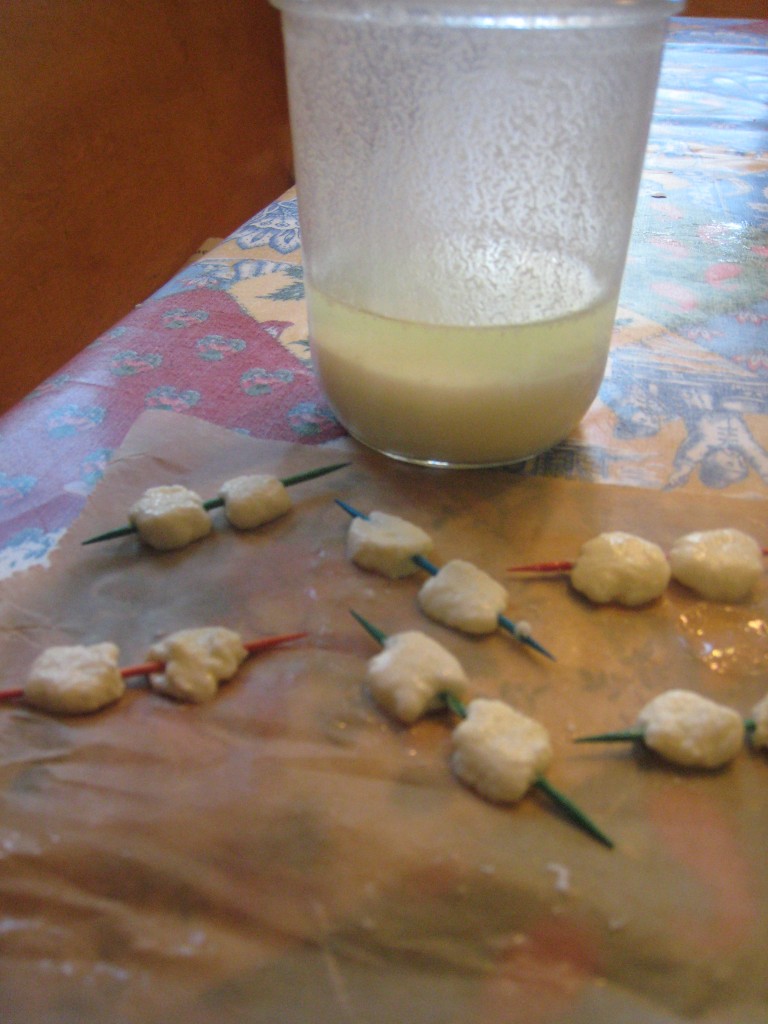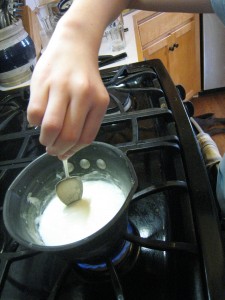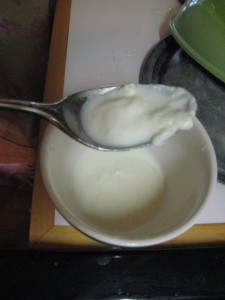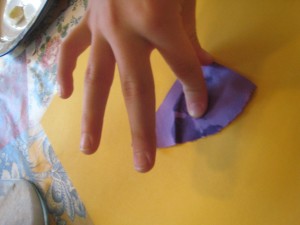Tag: glue’
Slime versus Slime
- by KitchenPantryScientist
A homemade slime craze is sweeping the nation, and glue is becoming a limited resource as stores are swarmed by school kids on a quest to make the perfect goo.
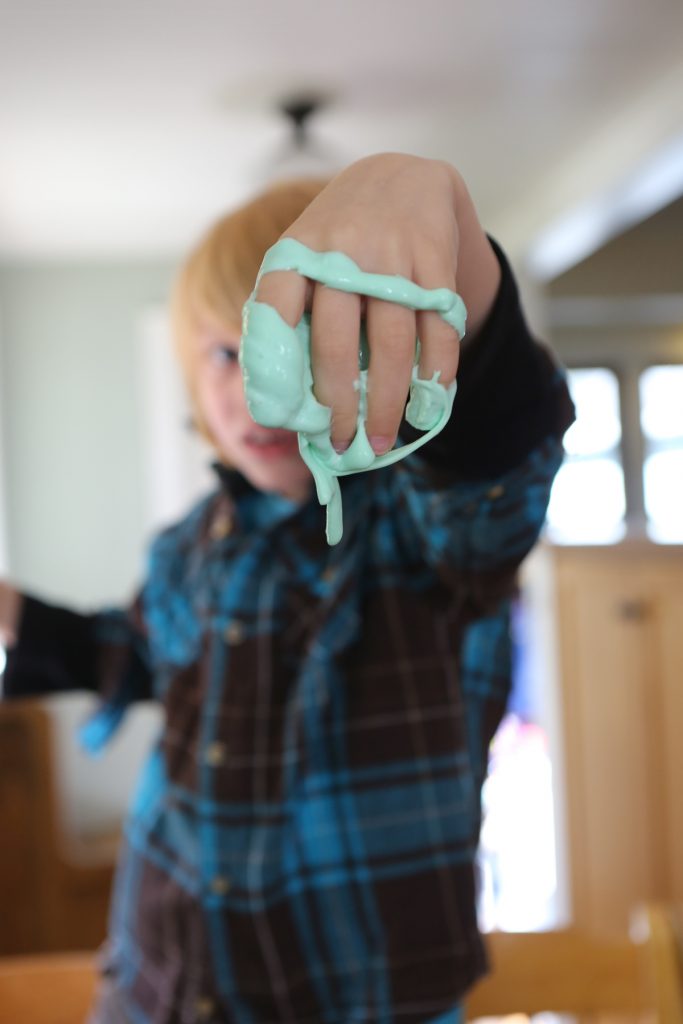
from Kitchen Science Lab for Kids (Quarry Books 2014)
I’ve posted recipes and videos for slime-making on this website and included one in “Kitchen Science Lab for Kids.” For my most recent book, “Outdoor Science Lab for Kids,” I invented a recipe for making slime that oozes from a bottle like a living thing.
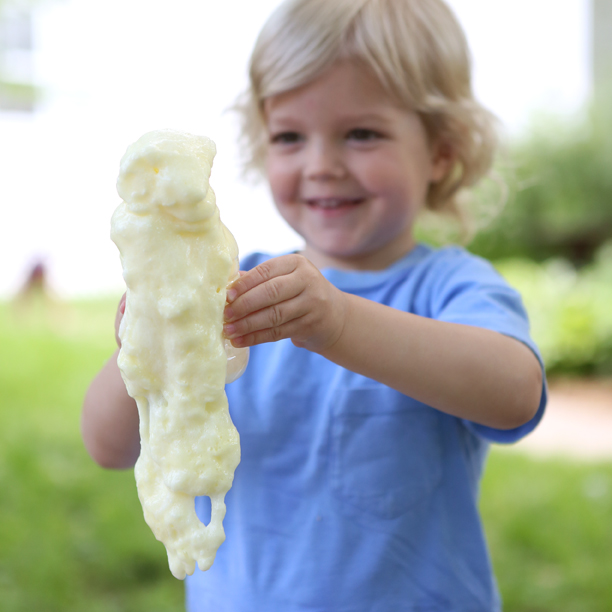
From “Outdoor Science Lab for Kids” (Quarry Books 2016)
But the other day, my 11-YO brought home a slime recipe featuring clear glue, baking soda, shaving cream and contact lens solution, and I was baffled. Which ingredient was the cross-linking chemical that would bind all of the glue molecules together into slime? I hadn’t had much luck using any cross-linker besides Borax laundry detergent.
Curiosity got the best of me, and a trip to Walgreens confirmed my suspicion that most contact lens solution contains boric acid, a cross-linking chemical related to Borax. In the glue aisle, I discovered a “Borax-free slime” recipe for slime made with Tide Free and Gentle. (Tide detergent does, in fact, contain the same chemical in Borax, so it’s not really Borax-free.)
A few days later, a friend called saying that the slime her kids were making with Borax and clear glue wasn’t turning out. That’s when I decided it was time for us to do some scientific sleuthing.
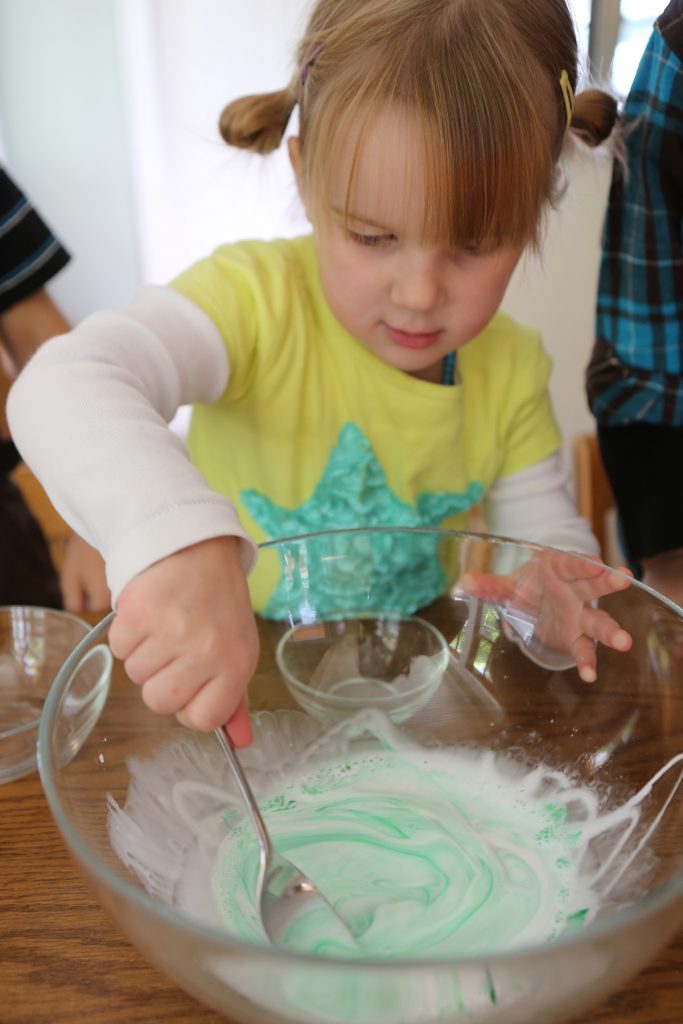
From Kitchen Science Lab for Kids (Quarry Books 2014)
We tested two glues (clear glue and white school glue) with three cross-linking solutions (Borax laundry detergent, contact lens solution, and Tide Free and Gentle (which contains some Borax) to see how the end-products would differ.
Helpful hints: A bottle of glue contains 4 or 5 oz, which is a little more than half a cup. Mix glue with other ingredients BEFORE adding the cross-linker. Keep slime away from toddlers, as ingredients may be harmful if consumed. Always wash your hands after playing with slime.
Here’s what we found:
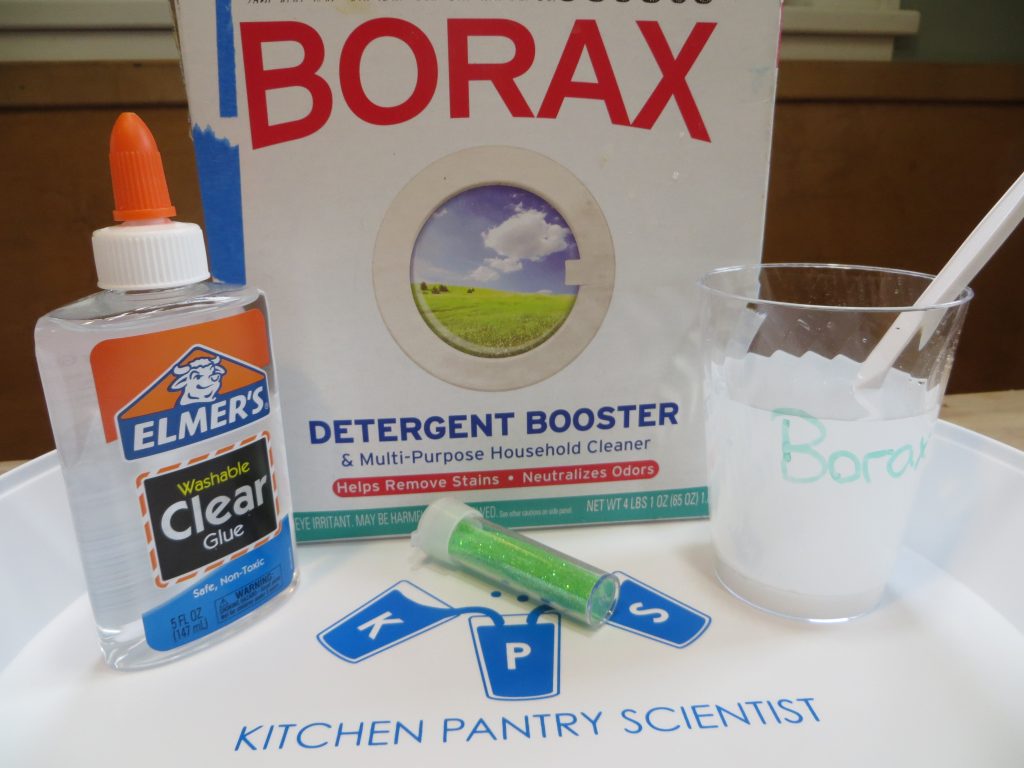
Traditional Borax Slime: Add equal parts glue and water (for example, one 5 oz bottle of glue+5 oz water.) Add glitter or food coloring. Dissolve a few spoonfuls of Borax in a cup of water to make a Borax solution. Add Borax solution to glue, a little at a time, until it no longer feels sticky.
-White school glue works best for this recipe and the result is smooth slime that can be rolled into long snakes.
-Clear glue doesn’t work well with this recipe and produces brittle slime. Save clear glue for the two recipes below.
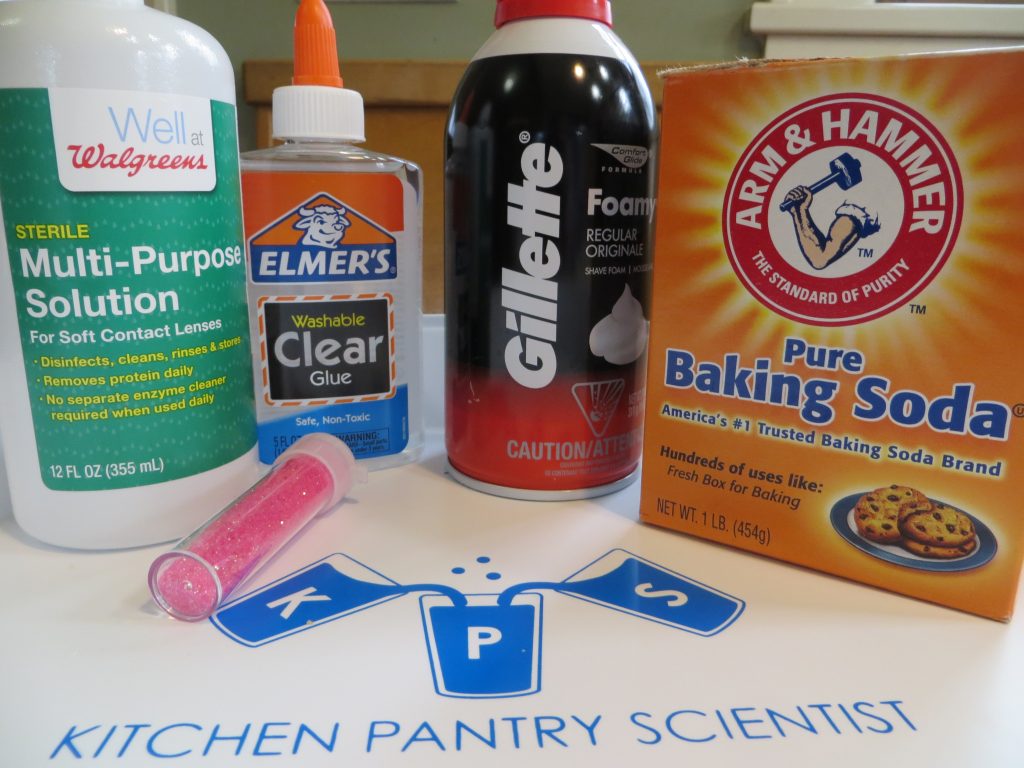
Puffy Slime: Add 5 oz glue to a large bowl. Stir in 1/2 tsp baking soda, 1/4 cup shaving cream and glitter or food coloring. Mix well. Add contact lens solution as a crosslinker and stir. Keep adding contact lens solution until your slime is no longer sticky and knead slime until it has the desired consistency.
-White school glue works well with this recipe and results in a puffier, firmer product than clear glue. The slime has a strong shaving cream smell.
-Clear glue works well for this project and produces nice, smooth puffy slime that smells like shaving cream.
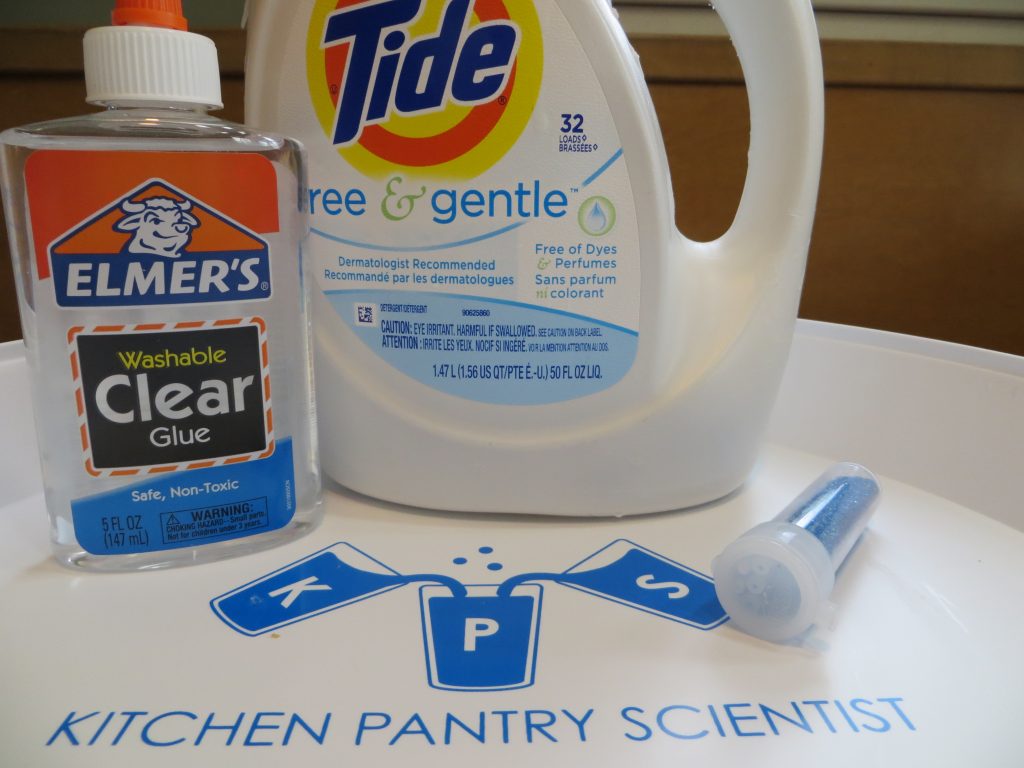
Tide Detergent Slime: Add 5 oz glue to a large bowl. Stir in 5 oz water and some glitter or food coloring. Add 1/4 cup of Tide Free and Clear laundry detergent. Mix well with a spoon and then hands to the desired consistency.
-White school glue works well with this recipe and the soap in the detergent makes tiny bubbles in the slime.
-Clear glue works well for this project and makes great , smooth slime that’s puffy from the soap in the detergent.
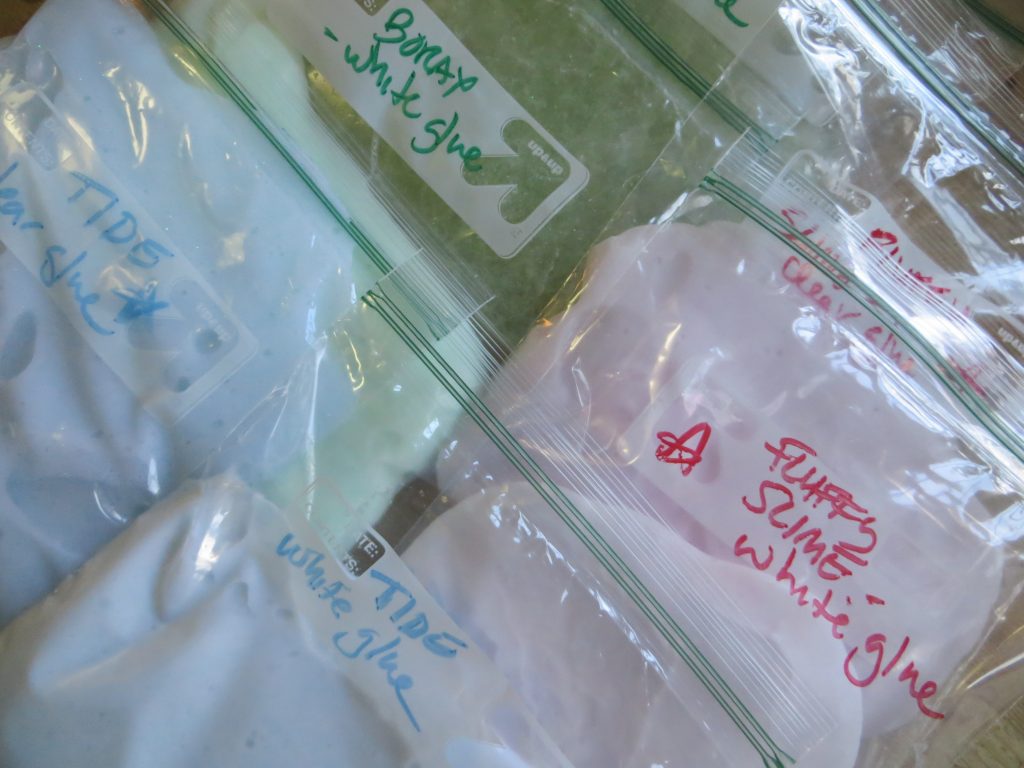
Try adding cornstarch, lotion, or anything else you can think of to perfect your recipe.
What are you waiting for? Go make some slime!
The Science Behind the Fun: A polymer is a long chain of repeating molecules, kind of like a string of pearls. The polymer in school glue is called polyvinyl acetate. Borax solution (sodium tetraborate) and boric acid (combined with baking soda to make borate), are cross-linking substances that make the polymer chains in glue stick together. As more and more chains stick together, they can’t move around and the solution gets thicker and thicker. Eventually, all the chains are bound together and no more Borax or boric acid solution can be incorporated into the slime.
Curds and Whey- Day 4 of Science Camp
- by KitchenPantryScientist
We discovered two easy experiments you can do with milk and vinegar. One is hot, and requires adult supervision, and the other is done at room temperature. Who knew you could make plastic and glue from milk?
Milk Plastic
The first experiment we tried was making “plastic” from milk curds. Heat about a cup of milk in a pan until it gets a scum on top or gets lumpy.
Skim off the scum (curds) with a spoon and put them into a small bowl to cool. Eventually, we got tired of skimming and just let a thick layer form on top of the liquid. Then, I poured the hot milk out of the pan and scraped out the curds with a spoon, adding them to the curds we’d already collected. Add a tsp. of vinegar and let the mixture cool for about an hour. Then, slowly pour off the liquid (we blotted some off with a paper towel too) and knead the “plastic”. You can shape your plastic into anything you want- beads, balls, animals and allow it to dry on a paper towel. When it’s dry, you can even paint it! Our plastic was very soft and gooey, so we rolled it into small balls on toothpicks to make beads.
Milk contains a protein called casein, which is a polymer, or a chain, or long molecules which can bend and move until the plastic hardens.
Homemade Glue
We also made glue using milk and vinegar. Just add a cup of milk and 1/3 cup white vinegar to a clear jar or bowl. Mix gently and allow the mixture to settle until you can see two layers. The curds are the white layer on the bottom of the jar and the whey is the liquid on top. Fish some of the curds out with a spoon or sieve, or just pour off the whey. The curds can be used as glue. We tried it and found that our homemade glue worked pretty well for gluing paper together!
The vinegar separates the milk, allowing the fat, minerals and casein protein to form curds. White glue is made from caseins of milk curds. Cheeses, as you probably already know, are made from curds.
I wonder how hard it is to make homemade edible cheese curds. Maybe that will be a project for another day.
Mad Scientist’s Green Slime
- by KitchenPantryScientist
What could be more fun than creating your own green slime to play with? It’s easy to synthesize your own green goo using only Elmer’s glue (the non-washable kind), Borax (found in the laundry detergent section of most stores), green food coloring and water.
In a bowl, have your child mix together about 1/3 cup glue and 1/3 cup water with a spoon or Popsicle stick. These measurements don’t have to be exact. Add a few drops of green food coloring and mix well.
To make the Borax solution, add around a cup of water to a jar. To the water, add about a Tablespoon of Borax. Have your child shake the jar to dissolve as much of the Borax as possible. You are making what is called a saturated solution, so it may not all dissolve! Don’t worry, it will work just fine.
Have your child add about a teaspoon at a time of the Borax solution to the glue/water mix. After each addition, have them stir the mixture together. You should see long strings begin to form and stick together. Keep adding Borax until the mixture doesn’t feel gluey any more. It will form sort of a shiny playdough-like substance. If you add too much Borax solution, it will feel wet. You should be able to just knead it a little to absorb the extra water! The slime is not toxic, but Borax is soap, so don’t let your kids eat it!
I am a biologist and not a chemist, but here is the science, as I understand it.
Mixing Elmer’s glue with water forms a substance called a polymer, which is a long chain of molecules. (A molecule is the smallest amount of a specific chemical substance that can exist alone, like H2O, a single water molecule). The polymer formed by water and glue is called polyvinyl acetate.
The Borax solution (sodium tetraborate) is a cross-linking substance that makes the polymer chains stick together. As more and more chains stick together, they can’t move around and the goo gets thicker and thicker. Eventually, all the chains are bound together and no more Borax solution can be incorporated.
You can store the slime in plastic bags. If you want to make a larger batch, just remember to mix equal amounts of glue and water and add as much Borax solution as needed.
To make your child feel like a “real” scientist, find an old, button up shirt for your child to use as his or her “lab coat”. It’s fun and will protect their clothes. You could even try to find some old safety goggles in your garage for your child to wear, although the ingredients for this project are relatively safe. (Very young children should always be supervised while doing science projects.)
Have fun!
